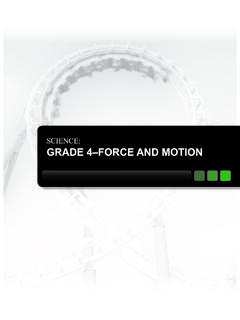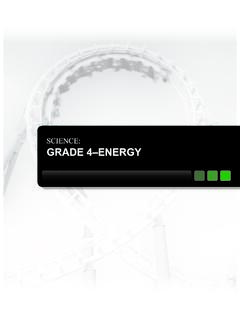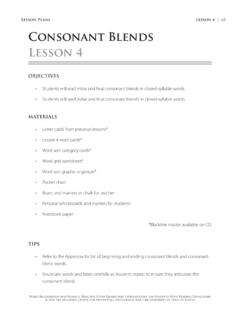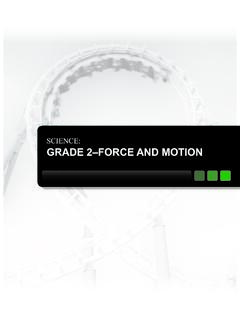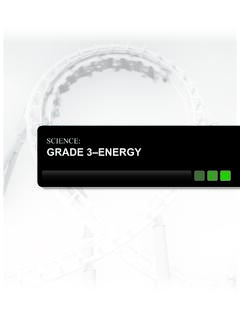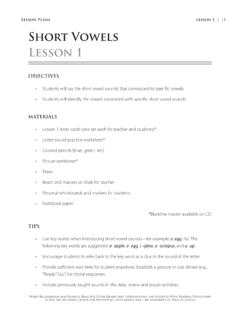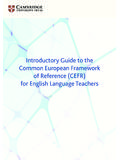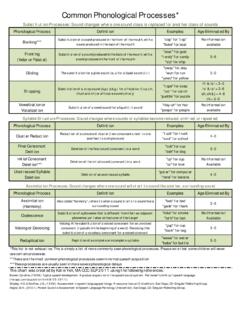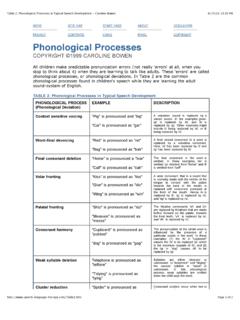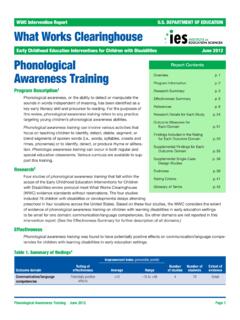Transcription of Phonological Awareness: An Essential Component of Reading ...
1 2016 The University of Texas System/Texas Education Agency Licensed under Creative Commons BY-NC-ND Awareness: An Essential Component of Reading Instruction 1 Phonological Awareness: An Essential Component of Reading InstructionMartha Hougen, Center for Collaboration for Effective Educator Development, Accountability, and Reform (CEEDAR) University of Florida IntroductionResearch in the field of Reading instruction during the past 3 decades has yielded a convergence of evidence supporting best practices. We know how to teach students how to read, including students from diverse back-grounds and with varying abilities.
2 Our challenge is how to ensure that each teacher has the knowledge and skills to implement what works for students in their classrooms. Of particular concern are students who have difficulty learning to read because they are learning English, have limited academic experiences, or have disabil-ities. To ensure that all students learn to read well, educators need to understand the Essential components of Reading instruction. Phonological awareness is one of the first and most critical skills teachers must teach stu-dents to master. Phonological awareness is the most potent predictor of Reading success (Liberman et al., 1989; National Reading Panel, 2000; Torgesen et al.)
3 , 1997). Note: In this brief, a pair of slanted lines (/ /) is used to denote a particular sound. For example, /c/ and /ake/ indicate the sound made by the c in cake and the sound made by the remaining letters, a k It IsPhonological awareness refers to the conscious awareness that language is composed of sounds and the ability of students to detect sounds in speech to learn sound-letter relations. It is an overarching concept that includes listening, rhyme and alliteration, sentence segmentation, and syllable and onset-rime blending and segmenting (Adams, 1990; Al Otaiba et al. 2012; Ehri, 2000). The most complex and most important Phonological skill is phonemic awareness (Torgesen et al.
4 , 2001; Troia, 2004), the awareness of the individual sounds in words and the ability to manipulate the sounds. This is discussed in more detail in the brief in this series Phonemic Awareness: The Single Sound experiences students have before entering school with their parents and other adults affect their develop-ment of oral language skills, listening skills, and vocabulary development all of which have a significant impact on later Reading development (Hart & Risley, 1995). By the end of kindergarten, most students have developed Phonological awareness and are ready to learn to read. However, some students need support in Phonological awareness through second grade or longer, and Phonological awareness is the most common difficulty for stu-Brief 5 July 2016 2016 The University of Texas System/Texas Education Agency Licensed under Creative Commons BY-NC-ND Awareness: An Essential Component of Reading Instruction 2dents with Reading disabilities such as dyslexia.
5 Thus it is important that parents and educators in prekindergar-ten and the early elementary grades have an understanding of Phonological to and recognizing sounds is an important skill that begins to develop before students start formal schooling. Toddlers can usually identify a door slamming, a truck driving past, or a helicopter or an airplane flying over them. They can also follow simple directions and say some words. Gradually, students need to think about words not only as having meaning, but also as a collection of sounds (O Connor, 2014). By age 5, most students can identify rhyming words and complete sentences such as the cat in the hat, or mouse in a house.
6 With support, students can make up sentences using alliteration, such as busy bees buzz or, using their own names, Freddie fights fires or Bradley bites bugs. Although these skills sound simple, some students need explicit instruction, with modeling and scaffolding, to become aware of rhymes and segmenting refers to the ability to recognize the separate words in a sentence. When you first learned a foreign language, you may remember having difficulty listening to a native speaker and not being able to identify the individual words. To support students in learning this skill, teach them to count words in a sen-tence, stomp for each word, clap the words, or move a manipulative, such as plastic chips, one for each word.
7 Syllable blending and segmenting develops the awareness that words are made of chunks or syllables. A syl-lable is a word or part of a word with one vowel sound. To introduce syllable blending and segmenting, it is best to start with compound words. For example, the teacher says birdhouse and asks the students what was the first word they heard, bird, and the second word they heard, house. The teacher says, Put them together and what is the word? Birdhouse. Again, using manipulatives or hand gestures provides a scaffold for blending and segmenting requires students to be aware of the initial consonants, up to the vowel (onset), and then the vowel and following letters (rime).
8 For example, in the word cake, the c is the onset and ake is the rime. When teaching this skill, it is important to use the letter sounds, not the names, as indicated by /c/ / k/. The most complex level of Phonological awareness is phonemic awareness, or the awareness of the individual sounds in words. This skill is most important for later Reading success, accounting for about 65% of the variance in Reading of first-graders and 49% of the variance of Reading skills of eighth-graders. (Vaughn Gross Center for Reading and Language Arts at The University of Texas at Austin, 2011). Students with phonemic awareness can identify the initial, final, and medial sounds in words and can segment and blend the sounds in words, as dis-cussed in the brief in this series Phonemic Awareness: The Single Sound 1.
9 Phonological Awareness Continuum 2016 The University of Texas System/Texas Education Agency Licensed under Creative Commons BY-NC-ND Awareness: An Essential Component of Reading Instruction 3 What It Looks LikeInstruction in Phonological awareness is most effective when done in small groups of eight students or fewer, if the students are struggling with the concepts. It is important for the teacher and students to be able to hear each other. The students also need multiple practice opportunities, so they should be required to say the words, word parts, and phonemes aloud as often as possible and to use tiles or other awareness instruction involves no print.
10 It can be done with eyes closed and lights off. Though Phonological awareness is an Essential foundation for Reading , it is a listening skill, not a Reading use manipulatives to scaffold their awareness of word parts and sounds. For example, they watch their mouth in a mirror while they make words and letter sounds, put their hand under their chin to feel it drop as they say syllables, and use tokens or sticky notes to represent word parts or letter teacher models clear diction, enunciating all the word parts and sounds correctly and clearly; no schwas are added to letter names ( , buh instead of /b/). The teacher models the left-to-right progression of Reading , which typically means mirroring the students.
